mobile View, to the German Version tap the flag


- Principality of Seborga
- independent since 1995
- internationally not recognized
- own name:
Italian: Principato di Seborga
• Flags
• Historical Flags
• Meaning/Origin of the Flag
• Coat of Arms
• Meaning/Origin of the Coats of Arms
• Numbers and Facts
• History
• Origin of the Country's Name
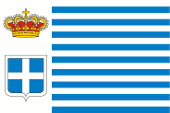
National and state flag,
ratio = 2:3(?),
Source, by: www.principatodiseborga.com



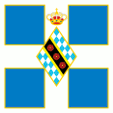
since 2019,
Flag of the Princess,
ratio = 1:1,
Source, by: www.principatodiseborga.com





12th cent. – 1729,
Flag of the Principality of Seborga,
Source, by: World Statesmen



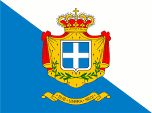
1995–1997,
National and state flag,
ratio = 3:4,
Source, by: Wikipedia (EN)




1997–2019,
Flag of the Prince,
ratio = 3:4,
Source, by: Wikipedia (EN)




The flag of Seborga shows eighteen stripes in white and blue and at the pole a white field with an white bordered blue coat of arms with a white isosceles cross. Above that a golden crown. The colours are probably historical because Seborga should have used until 1729 a white-blue diagonally divided flag. Obviously is the designing of the flag derived from two locally important Coat of arms. The scutcheon of the "Knights of San Monardo" and the scutcheon of the "Knights of the Corona" (look below).
Source: Volker Preuß

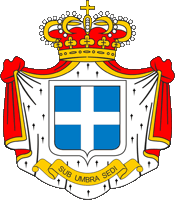
Coat of arms of the Principality of Seborga,
Source: www.principatodiseborga.com

Coat of arms of the village of Seborga,
Source: Wikipedia (DE)

Coat of arms of the Knights of San Monardo,
Source: uchterhous.org

Coat of arms of the Knights of the Corona,
Source: uchterhous.org

The coat of arms of the Principality of Seborga shows a white cross on a white bordered blue shield. Below the shield a golden banner with the motto of the principality: "sub umbra sedi" → "I sit in the shadow" The coat of arms is placed on a red scutcheon-coat which is decorate inside with ermine. Above it a golden crown. The colours of the coat of arms are possibly historic, because Seborga should have used until 1729 a white-blue diagonally divided flag. The heraldic origin of the isosceles cross is not known. The colour blue could got back to the Sacer Ordo Cisterciensis. Two local coats of arms are from a great importance. The scutcheon of the "Knights of San Monardo" and the scutcheon of the "Knights from the Corona". These are probably structures within the Seborghese – which see itself as the descendants of the crusaders in the middle ages – which once established this state. In this way the coat of arms of the "Knights of San Monardo" shows seventeen horizontal stripes. A clear indication for the seventeen families which the ca. 360 Seborhgese consist of. The coat of arms of the "Knights from the Corona" shows the colours white and blue on a diagonally divided shield, a blue cross and four golden lilies. The color blue and as well the lilies could have their roots in the Sacer Ordo Cisterciensis. The coat of arms of the place of Seborga shows a red shield with a white miter, a green curved baton and two green palm tree twigs.
Source: Volker Preuß

Area: 5,4 square miles
Inhabitants: 297
Religions: mostly Roman Catholic
Density of Population: 55 inh./sq.mi.
Main Place: Seborga
official Language: Italian
Currency: Luigino and (de facto) 1 Euro (€) = 100 Cent
Time Zone: GMT + 1 h
Source: Wikipedia (EN)

early middle ages · Seborga is a fiefdom of the Counts of Ventimiglia
954 · Count Guido hands over the castle to the Benedictinian abbey of Lérins
1079 · principality in the Holy Roman Empire of German Nation with investiture of the prince-abbot by Pope Gregor VII.
1118 · Prince-Abbot Edouard – meanwhile an abbot of the Sacer Ordo Cisterciensis – nominates the first nine temple-knights (this was a secular state act, with that a Cisterciense de facto converts with its clerical and secular power as prince-abbot its abbey into a feudal state).
1127 · return of the temple-knights from the Levante, Bernhard of Clairvaux hallows Hugo of Paynes to the first High Master of the Templars Order, knights of the Templars Order become elected by the knights as princes in livetime
1666 · Seborga coins own coinage (Luigino)
1729 · the Cisterciense-Principality of Seborga becomes selled to Vittorio Amedeo II., Prince of Piemont, Duke of Savoyen and King of Sardinia, but the purchase was never registered and was never payed
1748 · Peace of Aachen, Seborga becomes not incorporated into the Republic of Genova
1815 · Vienna Congress, Seborga becomes not incorporated into the Kingdom of Sardinia
1861 · foundation of the Kingdom of Italy, Seborga is not mentioned in the founding file
1934 · recognition of the exterritoriality by the Italian chief of government Benito Mussolini
1946 · foundation of the Republic of Italy, Seborga is not mentioned in the founding file
1963 · the Seborghese (descendants of the crusaders in Seborga), maintain the tradition and elect Giorgio Carbone to the Prince Giorgio I.
23rd of April 1995 · in a referendum the Seborghese support with 98% the new constitution and in this way the independence of the Principality of Seborga
24th of April 1995 · re-introduction of the Luigino currency
2009 · death of Prince Giorgio I.
2010 · elected successor is Prince Marcello I.
2019 · elected successor of Marcello I. is Princess Nina
Source: World Statesmen,
Wikipedia (EN)

The name Seborga has its roots in the Roman name "Castrum Sepulcri" (grave's castle). That became later "Sepulcri Burgum" and even later "Seporca" and finally "Seborga". The pristine inhabitants of Seborga name itself "Seborghese". These are seventeen families (a part of the total population), which see itself as the descendants of the crusaders in the middle ages, which once established that state. The other population are Italians, Frenchmen and Germans which live on the territory of the state, but they are none Seborghese and have in Seborga no right to vote.
Source: Wikipedia (DE),
www.seborga.homeip.net (Website no longer in operation)

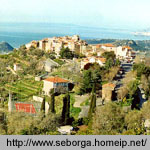

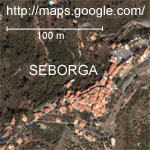
Surftipp: www.principatodiseborga.com

Kindly supported by: E. Hoheisel (D)
![]()






















